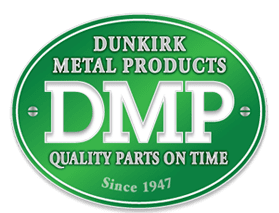Since 1947, Dunkirk Metal Products has been providing our customers with unique and custom solutions by utilizing our full precision sheet metal fabrication and stamping facility. The processes of Stamping and Fabrication are used to create similar end goods and parts, but the processes are quite different.
Prior to starting your next project, work with our team to determine which process is right for your project. We can breakdown potential options and streamline your process. Check out some of the key differences and advantages of Stamping and Fabrication!
Stamping is a straightforward process. A flat sheet of metal is placed on the press, and then is either bent, pressed, folded, or stretched. Stamping has a low unit cost of production, but requires investment in tooling. Stamping can produce large quantities in a timely matter, allowing for mass production of parts and production efficiency.
Stamping is the ideal choice for a job with a large quantity of repetitive parts that need to be produced. This justifies the cost of up-front tooling, and results in a lower overall cost per unit.
Fabrication is a bit more involved process – shaping metal into different parts by removing materials such as creating cutouts, or changing the material through bending and stretching. However, there is very little up-front cost for this and is ideal for smaller projects, or one-off’s.
Production volume can be adjusted to meet your specific needs when using Fabrication, and the lead time is much shorter as well.
Stamping and Fabrication are both effective methods, but Stamping is more use when a large quantity of repetitive parts are to be produced, or if you have repetitive orders. This justifies the cost of the up-front tooling cost and results in a lower overall cost per unit. If you have a smaller job, Fabrication might be the method to use!
If you have any questions or would like to discuss your project, give us a call! Our team and in-house engineers will help you develop the most financially sound plan and streamline your manufacturing process.



Leave A Comment